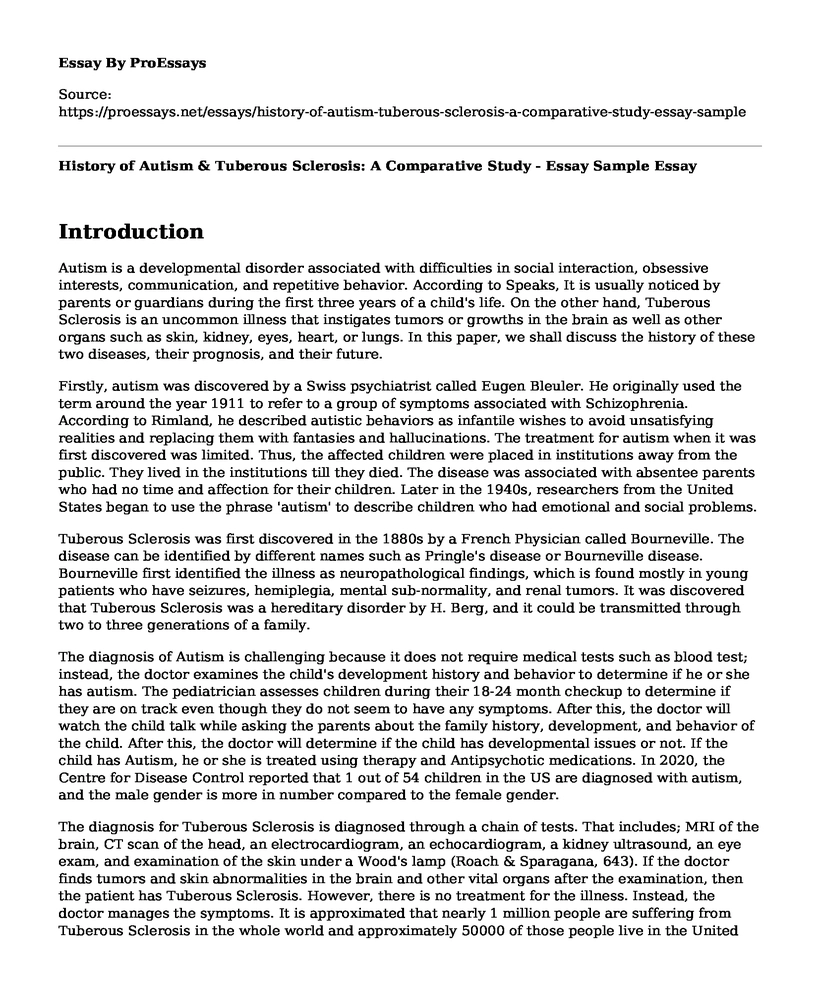Introduction
Autism is a developmental disorder associated with difficulties in social interaction, obsessive interests, communication, and repetitive behavior. According to Speaks, It is usually noticed by parents or guardians during the first three years of a child's life. On the other hand, Tuberous Sclerosis is an uncommon illness that instigates tumors or growths in the brain as well as other organs such as skin, kidney, eyes, heart, or lungs. In this paper, we shall discuss the history of these two diseases, their prognosis, and their future.
Firstly, autism was discovered by a Swiss psychiatrist called Eugen Bleuler. He originally used the term around the year 1911 to refer to a group of symptoms associated with Schizophrenia. According to Rimland, he described autistic behaviors as infantile wishes to avoid unsatisfying realities and replacing them with fantasies and hallucinations. The treatment for autism when it was first discovered was limited. Thus, the affected children were placed in institutions away from the public. They lived in the institutions till they died. The disease was associated with absentee parents who had no time and affection for their children. Later in the 1940s, researchers from the United States began to use the phrase 'autism' to describe children who had emotional and social problems.
Tuberous Sclerosis was first discovered in the 1880s by a French Physician called Bourneville. The disease can be identified by different names such as Pringle's disease or Bourneville disease. Bourneville first identified the illness as neuropathological findings, which is found mostly in young patients who have seizures, hemiplegia, mental sub-normality, and renal tumors. It was discovered that Tuberous Sclerosis was a hereditary disorder by H. Berg, and it could be transmitted through two to three generations of a family.
The diagnosis of Autism is challenging because it does not require medical tests such as blood test; instead, the doctor examines the child's development history and behavior to determine if he or she has autism. The pediatrician assesses children during their 18-24 month checkup to determine if they are on track even though they do not seem to have any symptoms. After this, the doctor will watch the child talk while asking the parents about the family history, development, and behavior of the child. After this, the doctor will determine if the child has developmental issues or not. If the child has Autism, he or she is treated using therapy and Antipsychotic medications. In 2020, the Centre for Disease Control reported that 1 out of 54 children in the US are diagnosed with autism, and the male gender is more in number compared to the female gender.
The diagnosis for Tuberous Sclerosis is diagnosed through a chain of tests. That includes; MRI of the brain, CT scan of the head, an electrocardiogram, an echocardiogram, a kidney ultrasound, an eye exam, and examination of the skin under a Wood's lamp (Roach & Sparagana, 643). If the doctor finds tumors and skin abnormalities in the brain and other vital organs after the examination, then the patient has Tuberous Sclerosis. However, there is no treatment for the illness. Instead, the doctor manages the symptoms. It is approximated that nearly 1 million people are suffering from Tuberous Sclerosis in the whole world and approximately 50000 of those people live in the United States (Curatolo & Bombardieri, 129).
Conclusion
To sum up, the paper has analyzed the history, current prognosis, and the future of Autism and Tuberous Sclerosis. We have determined that the two illnesses though different in nature, cause serious health issues to human beings. Therefore, I urge those who have family members or friends suffering from the two diseases to offer support and love to the affected because they need it.
Works Cited
Curatolo, Paolo, and Roberta Bombardieri. "Tuberous sclerosis." Handbook of clinical neurology 87 (2007): 129-151.
Rimland, Bernard. "Infantile autism." (1964).
Roach, E. Steve, and Steven P. Sparagana. "Diagnosis of tuberous sclerosis complex." Journal of child neurology 19.9 (2004): 643-649.
Speaks, Autism. "What is autism." Retrieved on November 17 (2011): 2011.
Cite this page
History of Autism & Tuberous Sclerosis: A Comparative Study - Essay Sample. (2023, May 18). Retrieved from https://proessays.net/essays/history-of-autism-tuberous-sclerosis-a-comparative-study-essay-sample
If you are the original author of this essay and no longer wish to have it published on the ProEssays website, please click below to request its removal:
- Work-ready Skills: A Personal Action Plan Example
- Cognitive Behavior Therapy for People With Schizophrenia Essay
- Essay Sample on Aboriginal Health and Cultural Safety
- Research Paper on Childhood Depression
- Paper Example on Mental Illness and Unprovoked Killing: A Washington Post Case Study
- Mental Health: Comp. Study of Players vs Non-Players - Essay Sample
- The Dual Nature of War and Love: Analyzing 'The Things They Carried' by Tim O'Brien - Free Essay







